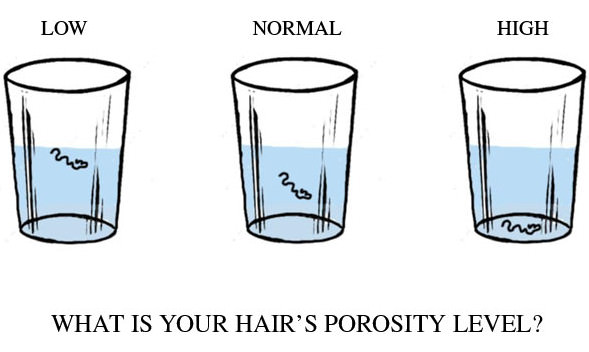
Porosity was one of those terms I’d heard floating around the natural hair community that I never took the time to research.
If you’re like me, you may have seen it too but weren’t too familiar with what it actually meant. It’s more common for people to regard hair typing as the best way to determine how to care for their hair but porosity shines a different light because it has to do with the condition of the strands themselves. By knowing your hair porosity, it’s easier to know how to care for your hair the right way.
So what is porosity?
Hair porosity is the hair’s ability to absorb and hold moisture. There are two ways to test hair porosity:
1. Pull a few pieces of hair from a comb/brush and place into a bowl of water (this is MUCH easier than trying to rip out a few strands).
Let it sit for 2-4 minutes. If the hair is floating at the top that means that you have low porosity hair. If the hair sits in the middle you have medium porosity hair (also known as normal porosity hair); if it sinks to the bottom you have high porosity hair.
2. The second method is the strand test. Take a single strand of hair with your fingers and slide your finger up the shaft. If you feel little bumps then it means your cuticle is lifted and you have high porosity hair. If the shaft is smooth that means you have low porosity hair.
I did this impromptu scientific experiment sitting in my bedroom with my best friend. We dropped a few strands of our hair into a small bowl of water and watched it sit for a few minutes. I found out that I had high porosity hair. She, on the other hand had low porosity hair (her hair type is also about 3a, 3b). Her individual strands are thicker and stronger than mine.
…So why do you care, and what exactly does all of this mean?
Low Porosity Hair is hair that doesn’t really allow water and moisture in (that’s why it stayed at the top of the water during the water test).
It means there is a tightly bound cuticle layer with overlapping scales and it lays flat. Low porosity hair is usually shiny, repels moisture, and is hard to process with chemicals. It can also accumulate build up from protein deep conditioners, which leaves it feeling like stiff straw.
Humectants like glycerin and honey*, and emollients like Shea butter*, coconut* and jojoba* oils* are good for this hair porosity. Also opt for more liquid based products instead of very thick ones.
Wow! I’ve always been told that my hair was very porous but I did the test anyway..guess what??? The hair was at the bottom of the glass in less than 5 seconds!!
Doesn’t that mean it IS very porous if it sinks…?
Low porosity and I checked when I was relaxed, transitioning, and natural (just so I was 100% positive I was doing the test correctly).
informative! Thanks
I still don’t get this…my hair floats unless it’s touched then it sinks…if I pull it out of the water and drop it back in the water…it floats again. Either this is bogus or my hair doesn’t know what it is.
I think its bogus as hell….many people have gotten good results so maybe you and I are the bogus ones lol. But no seriously, I am having a hard time with it too.
If the hair strand your using has products on it (leave in, oils, gels etc) then the hair will float no matter what. You need to do the test in Freshly washed hair before you added any products to it.
Low
Normal porosity. Mine floated like it took summer swimming lessons.
Mine floated for a minute then started to sink.
I think porosity can be changed. When I first went natural my hair’s porosity was low now after 6 years it’s high.
You are absolutely right. Deep conditioning often increases hair porosity.
I need to DC more often.